Pol Pot. The Khmer Route. Part of 4. The fall of the regime and twenty years of war in the jungle
Anti-Vietnamese Khmer Rouge Policy
Pol Pot himself was very negative about Vietnam and its role in Indo-Chinese politics. After the Khmer Rouge came to power, the policy of purging the Vietnamese population began in Democratic Kampuchea, as a result of which a significant part of the Vietnamese fled across the border. At the same time, official Kampuchean propaganda blamed Vietnam for all the problems of the country, including the failures of the economic policies of the Pol Pot government. Vietnam was presented as the exact opposite of Kampuchea, much was said about imaginary Vietnamese individualism, which was opposed to Kampuchean collectivism. The image of the enemy helped unite the Kampuchean nation and strengthen the mobilization component in the life of Kampuchea, which already existed in constant tension. All the negative moments in the life of the Kampuchean society, including the “excesses” of Pol Pot's repressive policies, were written off to the intrigues of the Vietnamese.
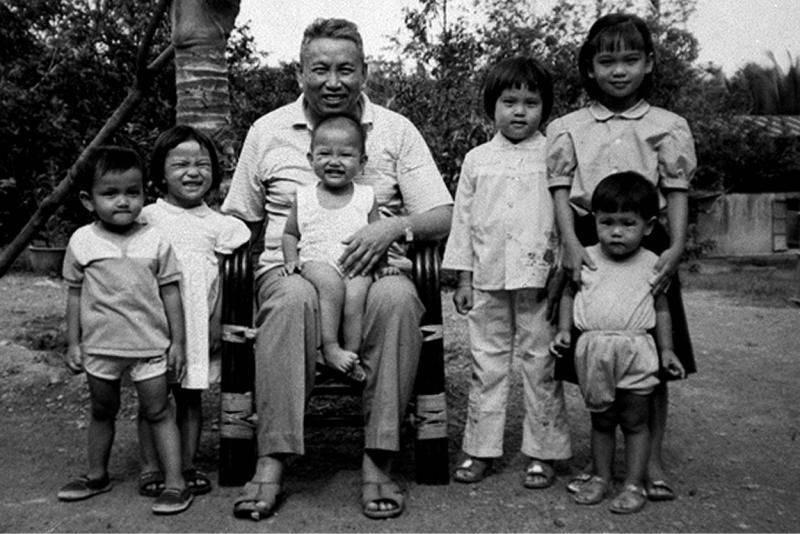
Anti-Vietnamese propaganda was particularly active in affecting the peasant youth, who formed the main support of the Khmer Rouge and their main mobilization resource. Unlike adult Kampucheans, especially representatives of the urban population, many young residents of remote villages did not even see Vietnamese in their lives, which did not prevent them from considering them as their sworn enemies. This was facilitated by the official propaganda, which proclaimed that the main task of Vietnam was to exterminate the Khmers and seize the territory of Kampuchea. However, behind the anti-Vietnamese rhetoric of the Kampuchean authorities were not only Pol Pot's personal hatred for the Vietnamese and the need to create an image of the enemy to mobilize the population of Kampuchea. The fact is that Vietnam was the main conductor of Soviet influence in Southeast Asia, which China did not like very much. With the hands of the Khmer Rouge, China actually tested Vietnam for strength and declared its claims to leadership in Indochina and in the revolutionary communist movement in Southeast Asia. On the other hand, for Pol Pot, the confrontation with Vietnam was a chance to expand the volume of Chinese material, financial and military support. The Khmer Rouge leadership was convinced that in the event of a conflict with Vietnam, China would provide comprehensive assistance to Democratic Kampuchea.
The formal provision of the anti-Vietnamese rhetoric of the Cambodian authorities was based on the confessions of alleged Vietnamese agents of influence that were beaten out in Kampuchea prisons. Under torture, the arrested people agreed with all the charges and testified against Vietnam, who allegedly recruited them for sabotage and espionage activities against Kampuchea. Another justification for the anti-Vietnamese position of the Khmer Rouge was territorial claims. The fact is that the territory of Vietnam included territories inhabited by “Khmer Krom” - ethnic Khmer who found themselves after the independence of Vietnam and Cambodia were part of the Vietnamese state. The Khmer Rouge sought to revive the former power of the Khmer Empire, only in the form of a communist state, so they also advocated the return of Khmer lands to the Democratic Kampuchea. These lands were in the east part of Vietnam, and in the west part of Thailand. But Thailand did not occupy, in contrast to Vietnam, an important place in the aggressive policy of Democratic Kampuchea. Democratic Kampuchea’s Defense Minister Son Sen constantly reminded Pol Pot that his troops were unhappy with the Khmer lands being part of Vietnam and were ready to weapons in their hands to return them to Kampuchea. In the agricultural communes of the country, meetings were regularly held at which psychological treatment of the peasants was conducted with the aim of setting up the population for the impending war with Vietnam. At the same time, already from 1977, the Khmer Rouge began the tactics of constant armed provocations on the Kampuchea-Vietnamese border. Attacking the Vietnamese villages, the Khmer Rouge hoped that in the event of a serious military confrontation, Kampuchea would use the help of China. To do this, Chinese military advisers and specialists were invited to the country - according to various sources, from 5 to 20 thousands of people. China and Kampuchea strongly emphasized the importance of bilateral relations and declared the special character of the Chinese-Cambodian friendship. Pol Pot and members of his government visited the PRC, met with the country's top leadership, including Marshal Hua Guofeng. By the way, the latter, at a meeting with the leaders of the Khmer Rouge, declared that the PRC supports the activities of Democratic Kampuchea in the direction of further revolutionary transformations.
Against the background of maintaining friendly relations with China, relations with Vietnam and the Soviet Union behind it continued to deteriorate. If, after the Khmer Rouge came to power, the Soviet Union reacted to it rather positively, as the communist forces still won, albeit with a slightly different ideology, by the end of 1977 the Soviet leadership realized its anti-Vietnamese and anti-Soviet character polpotovskogo regime, distanced itself from the development of relations with Democratic Kampuchea. Increasingly, criticism of the government of the Khmer Rouge, who were openly accused of Maoism and the conduct of pro-Chinese policies in the country, began to be heard in the Soviet media and regional literature. Nevertheless, the leadership of the Communist Party of Vietnam attempted to normalize relations with neighboring Kampuchea, for which, in June 1977, the Vietnamese side turned to the Red Khmer with a proposal to hold a bilateral meeting. However, the government of Kampuchea in a response letter asked to wait with the meeting and expressed hope for the improvement of the situation on the borders. In fact, the Khmer Rouge did not want any normalization of relations with Vietnam. Even in spite of the fact that China preferred to keep a certain distance and not intervene openly in the Cambodian-Vietnamese confrontation.
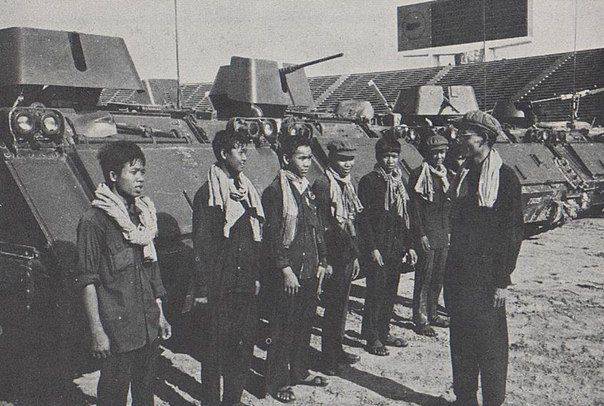
Cambodian-Vietnamese war 1978-1979
31 December 1977, the Khmer Rouge leadership, to the whole world, announced that Vietnam was taking acts of armed aggression against Democratic Kampuchea on the borders of the country. Naturally, after this demarche, the hope of normalizing relations was completely lost. The inevitability of open confrontation between the two states became obvious. Moreover, Kampponhnang had built a military air base from which Vietnamese territory could attack aircraft in the event of the outbreak of hostilities. Border provocations against Vietnam continued. So, on April 18 1978, an armed Khmer Rouge unit invaded the territory of the Vietnamese frontier province of Anqiang, which attacked the village of Batyuk. In the village began the total destruction of the local population. 3157 people died, including women and children. Only two villagers managed to escape. After this raid, the Khmer Rouge retreated to the territory of Kampuchea. In response, Vietnamese troops launched several raids into Kampuchean territory. It became clear that the large-scale military clash of the two states was not far off. Moreover, in Kampuchea, slogans were raised about the need for the complete destruction of all Vietnamese people and the genocide of the Vietnamese population of the country began. The attack on Batyuk and the killing of more than three thousand Vietnamese civilians was the last straw of patience for the Vietnamese authorities. After such a raid, it was not possible to tolerate the antics of the Kampuchean Khmer Rouge, and the Vietnamese military command began to prepare directly for the armed operation against Kampuchea.
However, without the support of at least part of the Khmer population, the actions of Vietnam could be perceived as aggression against Kampuchea, which potentially entailed the danger of China entering the war. Therefore, the Vietnamese leadership has stepped up its work to find those political forces in Kampuchea that could be considered as an alternative to the Polpotov Khmer Rouge. First of all, the Vietnamese leadership entered into negotiations with a group of old Kampuchean communists who had long lived in Vietnam and enjoyed the confidence of the Central Committee of the Communist Party of Vietnam. Secondly, those representatives of the Khmer Rouge, who, for whatever reason, in 1976-1977, became a possible support of Vietnam. ran into the territory of Vietnam, fleeing political repression. Finally, there was hope for an armed uprising against Pol Pot of part of the Khmer Rouge, dissatisfied with the policy of the leadership of Kampuchea and located on the territory of Kampuchea itself. First of all, it was the head of the Eastern Administrative Zone So Phim, which we wrote about in the previous part of our story, and his political associates. The Eastern Administrative Zone maintained de facto independence from Pol Pot and in every way hampered the policy of Phnom Penh. In May 1978, the troops subordinated to So Phim, raised an uprising against Pol Pot in eastern Kampuchea. Naturally, this speech was carried out not without the support of Vietnam, although openly Hanoi had not yet decided to speak out against Kampuchea. However, the uprising was brutally suppressed by the Khmer Rouge, and So Phim himself was killed. The hopes of the Vietnamese for the transition to opposition to Pol Pot Nuon Chea, who occupied one of the most important places in the hierarchy of the Khmer Rouge and was traditionally considered a “pro-Vietnamese” politician, did not materialize either. Nuon Chea not only did not go over to the side of Vietnam, but also remained with Paul Poet almost to the end. But Vietnam has an ally in the face of Heng Samrin.
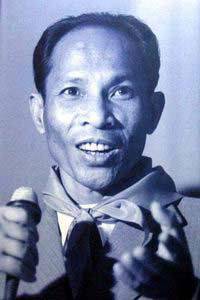 Heng Samrin (born 1934) came from a poor peasant family who from the early years participated in the national liberation and communist movement in Cambodia. After the victory of the Khmer Rouge, Heng Samrin, who commanded one of the regiments of the National Liberation Army of Kampuchea, was appointed to the position of political commissar of the division, then - commander of the division. At the time of the uprising in the Eastern Administrative Zone, Heng Samrin held the position of deputy chief of staff of this zone. In 1978, he refused to submit to Pol Pot and took the lead of a subordinate division against the Khmer Rouge. He managed to capture part of Kampong Cham province, but then the Khmer Rouge were able to force Heng Samrin’s troops to the Vietnamese border. The Vietnamese leadership decided to use Heng Samrin and his supporters to give legitimacy to their further actions - they say, we do not just invade Kampuchea in order to overthrow its government, but support a sensible and moderate part of the Kampuchean communist movement. For this 2 December 1978 in the province of Kratie, on the border with Vietnam, the United Front for National Salvation of Kampuchea was created. Seventy people took part in its founding congress - the pro-Vietnamese veterans of the Kampuchean communist movement. Heng Samrin was elected chairman of the front.
Heng Samrin (born 1934) came from a poor peasant family who from the early years participated in the national liberation and communist movement in Cambodia. After the victory of the Khmer Rouge, Heng Samrin, who commanded one of the regiments of the National Liberation Army of Kampuchea, was appointed to the position of political commissar of the division, then - commander of the division. At the time of the uprising in the Eastern Administrative Zone, Heng Samrin held the position of deputy chief of staff of this zone. In 1978, he refused to submit to Pol Pot and took the lead of a subordinate division against the Khmer Rouge. He managed to capture part of Kampong Cham province, but then the Khmer Rouge were able to force Heng Samrin’s troops to the Vietnamese border. The Vietnamese leadership decided to use Heng Samrin and his supporters to give legitimacy to their further actions - they say, we do not just invade Kampuchea in order to overthrow its government, but support a sensible and moderate part of the Kampuchean communist movement. For this 2 December 1978 in the province of Kratie, on the border with Vietnam, the United Front for National Salvation of Kampuchea was created. Seventy people took part in its founding congress - the pro-Vietnamese veterans of the Kampuchean communist movement. Heng Samrin was elected chairman of the front. Preparations for the invasion of Kampuchea intensified in the fall of 1978, which was also reported to the Soviet side, which did not directly participate in organizing the invasion, but in fact supported the Vietnamese line on Kampuchea. The Vietnamese military command was not afraid of a quick entry into the war of China, since, according to the Vietnamese, China simply would not have time to react to the lightning-fast throw of the Vietnamese troops. The Vietnamese Popular Army exceeded the Kampuchean armed forces in terms of numbers, weapons, and level of combat training. Therefore, the outcome of the collision, in principle, turned out to be predetermined from the very first days of the conflict. Starting hostilities, the Vietnamese did not even doubt their own victory, as the Soviet political and military leadership asserted. At the head of the Vietnamese troops preparing for the invasion of Kampuchea, was General of the Army Van Tien Dung (1917-2002) - a Vietnam national liberation war veteran who developed and implemented the plan of the Spring Offensive of the year 1975, as a result of which South Vietnam fell. Van Chien Dung was considered one of the most successful commanders of Vietnam, the second after Waugh Nguyen Ziapa.
December 25, 1978 from the Vietnamese city of Banmethuot tank and motorized rifle units of the Vietnamese army. They quickly crossed the border with Kampuchea and entered its territory. The offensive involved 14 Vietnamese divisions. The Khmer Rouge squads stationed on the border did not show any serious resistance, so very soon the Vietnamese troops advanced deep into Kampuchea towards Phnom Penh. Despite the loud statements of the Cambodian leadership about the inevitable defeat of the Vietnamese and the victory of the Cambodian people, very soon the Vietnamese managed to advance to the capital of the country. January 1, 1979 the fighting was already in the vicinity of the capital. On January 5, 1979, Pol Pot called on Kampuchea and the Kampuchean people to wage a war with "Soviet military expansion." Mention of Soviet military expansion was obviously made to attract the attention of China, as well as possible interference by the West. However, neither China nor Western countries provided military support to the Pol Pot regime. Moreover, on the advice of the Chinese, Pol Pot facilitated the evacuation of Prince Norodom Sihanouk from the country, ostensibly so that the prince represents the interests of Democratic Kampuchea at the UN. In fact, the Chinese were much more interested in Norod Sihanouk in this situation than Pol Pot. Sihanouk was the legitimate head of the Cambodian people and as such was recognized by the international community. Naturally, if Sihanouk was successfully lured to its side, China, even in the event of the collapse of the Polpot regime, could in the long run count on regaining control of Cambodia. The position of Pol Pot was becoming increasingly precarious. On the morning of January 7, 1979, a few hours before the Vietnamese troops entered the capital of Democratic Kampuchea Phnom Penh, Pol Pot left the city with his closest associates. He flew by helicopter to the west of the country, where military units that remained loyal to the leader of the Khmer Rouge retreated. Khmer Rouge Foreign Minister Ieng Sari escaped from Phnom Penh “on his own” and only reached the border with Thailand on January 11, torn off and even lost his shoes. He was clothed and shod at the Chinese Embassy in Thailand and sent to Beijing. The Vietnamese forces, having entered Phnom Penh, officially transferred power in the country to the United Front of National Salvation of Kampuchea, led by Heng Samrin. Formally, EFNSK and Heng Samrin were positioned as the forces that liberated Kampuchea from the dictatorship of Pol Pot.
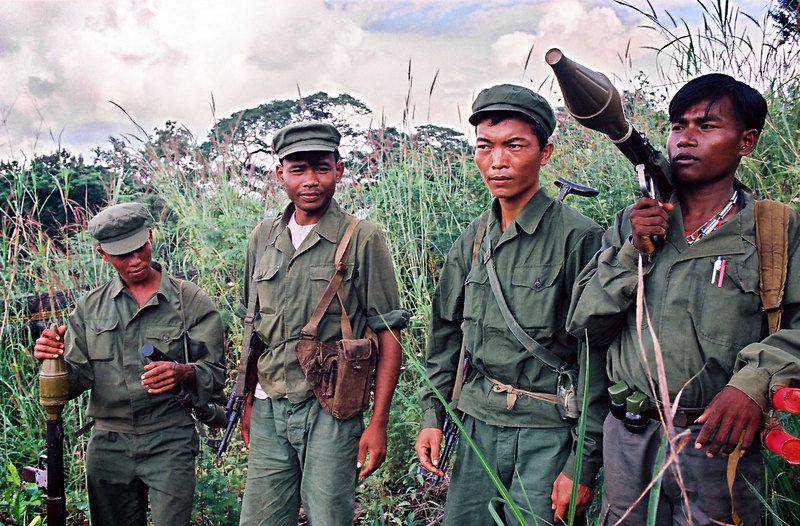
The Fall of Democratic Kampuchea and the Kampuchea People's Republic
10 January 1979 was proclaimed by the People’s Republic of Kampuchea (NRK). In the part of Cambodia occupied by the Vietnamese, the formation of new power structures under the control of the United Front of National Salvation of Kampuchea began. The backbone of these structures were representatives of the "middle link" of the Kampuchean Communists, who switched to the Vietnamese side. At first, the power of the new government rested on the direct power support of Vietnam. The world community did not recognize the People’s Republic of Kampuchea. Despite the war crimes of the Polpot regime that became known, it was the representative offices of Democratic Kampuchea that for a long time were considered by most countries as legitimate, while the NRC was recognized only by pro-Soviet countries that were members of the Council for Mutual Economic Assistance. For the NRC, the lack of real local authority has become a serious problem. It was planned to form people's committees, but this process went slowly and with great difficulties. In fact, it was only in Phnom Penh that the central authorities of the EFNSK were operating, relying on the assistance of Vietnamese advisers, both military and civilian. The core of the new regime was the Communist Party of Kampuchea (CPC), supported by Vietnam and representing an alternative to the half-Communist Communist Party of Kampuchea. Practically in all regions of the country not only were the squadrons of the Vietnamese People’s Army stationed, which remained the main force mainstay of the regime, but also housed Vietnamese civilian administrative and engineering advisers who helped the new government to establish a system of governance and organization of the national economy.
The contradiction between the two groups of the new elite - the former military and political leaders of the Eastern zone of Democratic Kampuchea, who have gone over to the side of Vietnam, and the old veterans of the Kampuchean Communist Party, who lived in 1950-1960-s, also became a serious problem of the new government. and never recognized Pol Pot as the leader of the country's communist movement. The interests of the latter were represented by Pen Sovan (Rod.1936). Pen Sovan was not just a veteran of the Cambodian revolutionary movement, but also a major of the Vietnamese People’s Army. At the beginning of 1979, the group under his leadership held the “third congress” of the Kampuchea People’s Revolutionary Party (NRPK), thus not recognizing the “illegitimate” congresses in 1963, 1975 and 1978 Pen Sovan was elected General Secretary of the Central Committee. However, the creation of the NPC before 1981 was kept secret. Heng Samrin was appointed head of the People’s Revolutionary Council. Formally, he was considered the head of the new revolutionary government, although he was in fact subordinate to the Vietnamese advisers.
Thus, by 1980, the most significant positions in the leadership of the NRC and the NRP were held by Heng Samrin, Pen Sovan and Chea Sim - also the former “Red Khmer”, who joined the Vietnamese side with Heng Samrin. In the summer of 1979, meetings of the Kampuchea Revolutionary People’s Tribunal began, at which 15-19 on August, Pol Pot and Ieng Sari were sentenced in absentia to the death penalty for committing numerous crimes against the Kampuchean people. It was during this period that widespread coverage of the Khmer Rouge repressive policy, which was carried out in 1975-1978, began. The new leaders of Kampuchea announced the number of Cambodian citizens killed during the three years of the Khmer Rouge rule. According to Pen Sovana, 3 100 000 people were killed at Pol Pot. However, this figure - over 3 million. People - is denied by the Khmer Rouge itself. Thus, Pol Pot himself in a recent interview that the Khmer Rouge leader gave in December 1979 reported that during his leadership more than several thousand people could not die. Khieu Samphan later stated that the 11 000 dead were Vietnamese agents, the 30 000 were infiltrated by Vietnamese, and only 3000 Kampuchean people died as a result of the mistakes and excesses of the Khmer Rouge local policy. But, according to Khieu Samphan, at least one and a half million inhabitants of the country died as a result of the actions of the Vietnamese troops. Of course, that the last words no one took seriously.
After the occupation of Phnom Penh by Vietnamese troops and the formation of the government of the People’s Republic of Kampuchea, the Pol Khmer-controlled Khmer Rouge troops retreated to the western part of the country, to the border with Thailand. This region for many decades became the main stronghold of the Khmer Rouge. In the first months after the fall of Phnom Penh, the Vietnamese surrendered to captivity, and about 42 of thousands of soldiers and officers of the Khmer Rouge army were killed or captured. Loyal to Pol Pot the troops suffered serious losses and lost their positions in the country. Thus, the general headquarters of the Khmer Rouge in Amleang, the bases in the province of Pursat and the river fleet based in the province of Kahkong were destroyed.
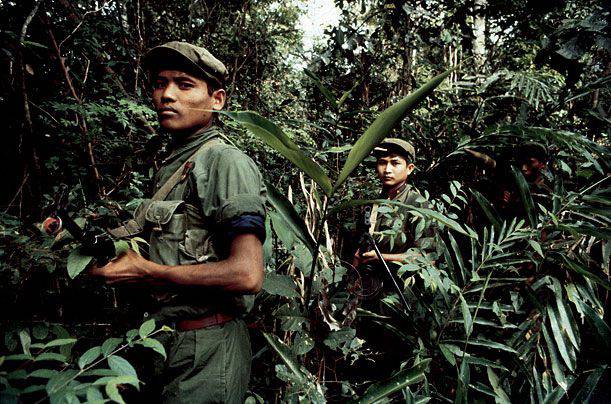
War in the jungle. The Khmer Rouge against the new government
However, gradually, the Khmer Rouge was able to recover from the strikes inflicted by the Vietnamese. This was facilitated by the general change in the military-political situation in Indochina. If formerly Democratic Kampuchea was supported only by China, then after the invasion of Kampuchea by the Vietnamese troops, Thailand and the United States were behind the Khmer Rouge, who were trying to prevent the strengthening of the Vietnamese and, therefore, Soviet positions in Indochina and Southeast Asia . In the partisan resistance of the Khmer Rouge, the American leadership saw an obstacle to the further advance of the USSR in Indochina. China’s secret agreements were concluded with Thailand, according to which China refused to support the Thai Communist Party, which fought a partisan war against the royal regime of the country, and Thailand, in turn, provided its territory for the Khmer Rouge bases.
Secretly, the position of Thailand was welcomed by the United States, which also came out in support of the representation of Democratic Kampuchea at the United Nations by the Polpotov delegation. Enlisting the support of the United States, China, and Thailand, Pol Pot intensified hostilities against the new Kampuchean government and the Vietnamese troops supporting it. Despite the fact that China was formally defeated in the short-term Sino-Vietnamese war, it continued to provide military and logistical assistance to the Khmer Rouge. Paul Pot by 1983 managed to create nine divisions and form the Ronse group to act in the rear of the new Kampuchean government. Steps have been taken to break out of international isolation. In particular, representatives of the Khmer Rouge, along with supporters of Son Sann and Norodom Sihanouk, joined the coalition government of Cambodia, recognized by the United Nations and by a majority of non-pro-Soviet countries. In 1979-1982 The coalition government was headed by Khieu Samphan, and in 1982, he was replaced by Son Sann (1911-2000), a veteran of Cambodian politics, Norodom Sihanouk’s longtime associate, who remained in charge of the coalition government until 1993. Khieu Samphan himself in 1985 was proclaimed the official successor of Pol Pot as leader of the Khmer Rouge and continued to lead the activities of the Khmer Rouge guerrilla groups in the jungles of Cambodia. The formal president of Democratic Kampuchea was proclaimed by Prince Norodom Sihanouk, Son Sann became prime minister, Khieu Samphan became deputy prime minister. At the same time, the actual power over the rebel formations remained in the hands of Pol Pot, who remained commander-in-chief of the armed forces of the Khmer Rouge and the leader of the Kampuchea Communist Party.
Pol Pot remained under the control of impressive military units - about 30 thousand people. Another 12 of thousands of soldiers were listed in the monarchical grouping Sihanouk and 5 of thousands of soldiers in units subordinating to Son Sannu. Thus, the new government of Kampuchea was opposed by about 50 of thousands of fighters based in the western regions of the country and in the territory of neighboring Thailand, supported by Thailand and China, and indirectly by the USA. China provided military assistance to all the groups that fought against the Vietnamese government of Kampuchea, but 95% aid came from the Khmer Rouge groups. Only 5% of Chinese weapons and equipment received troops, controlled directly by Sihanouk and Son Sanna. The latter were more assisted by the United States, but preferring to act not openly, but through controlled funds. Singapore and Malaysia also played an important role in helping the anti-government groups in Cambodia. At some point, it was Singapore’s help that was decisive. We should not forget about the important role of refugee camps. On the territory of Thailand in the 1980-s. there were tens of thousands of Cambodian refugees who were deployed in camps set up under the control of the UN and the Thai government. However, many refugee camps were in fact the bases of the Khmer Rouge combat units. Among the young refugees, the Khmer Rouge recruited fighters, and they were trained and deployed there.
During the 1980-x-1990-x. "Khmer Rouge" waged a partisan war in the jungles of Cambodia, occasionally making attacks and attacks in major cities of the country, including the capital Phnom Penh. Since the Khmer Rouge were able to regain control over a number of rural areas of the country, transport links between its regions, including the most important cities of the country, were seriously hampered in Kampuchea. In order to deliver cargo, it was necessary to organize a powerful escort by Vietnamese military units. However, the Khmer Rouge failed to create “liberated areas” in the provinces of Kampuchea far from the Thai border. The insufficient level of combat training of the Khmer Rouge, the weakness of the material and technical base, and the lack of broad support from the population also had an effect. In 1983-1984 and 1984-1985 large-scale military operations of the Vietnamese army against the Polo-poets were undertaken, leading to the defeat of the Khmer Rouge bases in a number of areas of the country. In an effort to increase support from the country's population, the Khmer Rouge gradually abandoned purely communist slogans and proceeded to the propaganda of Khmer nationalism. The main emphasis was placed on the seizure of the country's territory by Vietnam and the imaginary prospects for the Vietnamese settlement of the Kampuchean territory, as a result of which the Khmers would be expelled or assimilated. This propaganda found a response from a significant part of the Khmer, who traditionally had a very cool attitude towards the Vietnamese, and recently were very unhappy with the interference of Vietnam in the internal affairs of the country and, in fact, the complete control of the government of the People’s Republic of Kampuchea by the Vietnamese leadership. What played a role was the fact that, in a single bundle with the Khmer Rouge, Norod Sihanouk, heir to the royal dynasty, was considered by many Khmers to be the only legitimate ruler of the Cambodian state.
The decline of the Khmer Rouge and the death of Pol Pot
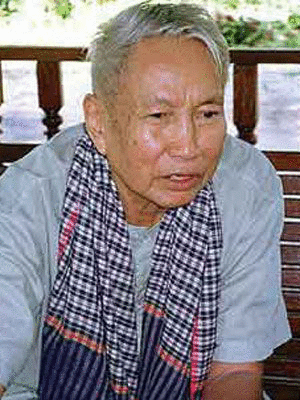 But by the second half of the 1980's. The Khmer Rouge gradually began to lose their positions. This was due to the beginning of the withdrawal of Vietnamese troops from the country and the transfer of the role of the main opponent of the Khmer Rouge to the Kampuchean army. In 1987, the formations of the coalition government of Democratic Kampuchea numbered about 54 thousand people, including 39 thousand people - in combat units. Over 20, thousands of militants operated on the territory of Kampuchea, the rest were deployed in Thailand. The Kampuchea armed forces numbered over 100 thousand people in regular units and 120 thousand people in the militia units. Gradually, the parties to the conflict came to realize the need for peace negotiations. The leadership of the Soviet Union was inclined to this opinion. Mikhail Gorbachev turned to a policy of constant and unjustified concessions to his political opponents, which ultimately contributed to undermining the political influence of the Soviet Union and strengthening the US position. Kampuchea was no exception - it was Moscow who was pressing hard on the Heng Samrin government with the goal of pursuing a policy of “reconciliation”. The Soviet Union actually became a mediator between Vietnam and People’s Kampuchea on the one hand, and Democratic Kampuchea, China and the United States on the other, while in the USSR negotiations actually lobbied the interests of the Chinese and American sides. US Secretary of State J. Schulz sent a letter to USSR Minister of Foreign Affairs Eduard Shevardnadze in Moscow, stating the need for international observation in Cambodia and the proclamation of head of state Norodom Sihanouk. The Soviet leadership forwarded this letter to Hanoi and Phnom Penh without comment, which in fact meant support by the Soviet Union of American proposals. At the same time, the USSR continued the policy of providing military assistance to the government of the People’s Republic of Kampuchea. However, the Cambodian leadership was forced to make concessions. The new Prime Minister Hun Sen in April 1989 renamed the People's Republic of Kampuchea to the State of Cambodia. In September, the last units of the Vietnamese army were withdrawn from Kampuchea’s 1989, after which an armed invasion of the opposition began from Thailand. However, the Cambodian army managed to repel the attacks of the Khmer Rouge. In 1991, the International Conference on Cambodia in Paris signed the Agreement on a Comprehensive Political Settlement of the Cambodian Conflict, the Agreement Concerning Sovereignty, Independence, Territorial Integrity and Immunity, Neutrality and National Unity, and the Declaration on Rehabilitation and Reconstruction. 21 September 1993. The National Assembly adopted a new constitution of the country, according to which Cambodia was proclaimed a constitutional monarchy, and Norodom Sihanouk returned to the royal throne.
But by the second half of the 1980's. The Khmer Rouge gradually began to lose their positions. This was due to the beginning of the withdrawal of Vietnamese troops from the country and the transfer of the role of the main opponent of the Khmer Rouge to the Kampuchean army. In 1987, the formations of the coalition government of Democratic Kampuchea numbered about 54 thousand people, including 39 thousand people - in combat units. Over 20, thousands of militants operated on the territory of Kampuchea, the rest were deployed in Thailand. The Kampuchea armed forces numbered over 100 thousand people in regular units and 120 thousand people in the militia units. Gradually, the parties to the conflict came to realize the need for peace negotiations. The leadership of the Soviet Union was inclined to this opinion. Mikhail Gorbachev turned to a policy of constant and unjustified concessions to his political opponents, which ultimately contributed to undermining the political influence of the Soviet Union and strengthening the US position. Kampuchea was no exception - it was Moscow who was pressing hard on the Heng Samrin government with the goal of pursuing a policy of “reconciliation”. The Soviet Union actually became a mediator between Vietnam and People’s Kampuchea on the one hand, and Democratic Kampuchea, China and the United States on the other, while in the USSR negotiations actually lobbied the interests of the Chinese and American sides. US Secretary of State J. Schulz sent a letter to USSR Minister of Foreign Affairs Eduard Shevardnadze in Moscow, stating the need for international observation in Cambodia and the proclamation of head of state Norodom Sihanouk. The Soviet leadership forwarded this letter to Hanoi and Phnom Penh without comment, which in fact meant support by the Soviet Union of American proposals. At the same time, the USSR continued the policy of providing military assistance to the government of the People’s Republic of Kampuchea. However, the Cambodian leadership was forced to make concessions. The new Prime Minister Hun Sen in April 1989 renamed the People's Republic of Kampuchea to the State of Cambodia. In September, the last units of the Vietnamese army were withdrawn from Kampuchea’s 1989, after which an armed invasion of the opposition began from Thailand. However, the Cambodian army managed to repel the attacks of the Khmer Rouge. In 1991, the International Conference on Cambodia in Paris signed the Agreement on a Comprehensive Political Settlement of the Cambodian Conflict, the Agreement Concerning Sovereignty, Independence, Territorial Integrity and Immunity, Neutrality and National Unity, and the Declaration on Rehabilitation and Reconstruction. 21 September 1993. The National Assembly adopted a new constitution of the country, according to which Cambodia was proclaimed a constitutional monarchy, and Norodom Sihanouk returned to the royal throne. These political events in the life of the country dealt a decisive blow to the positions of the Khmer Rouge and contributed to a serious split within the partisan movement itself. After China finally refused to support the Khmer Rouge, the latter received funds only from smuggling timber and precious metals to Thailand. The number of armed forces controlled by Pol Pot has decreased from 30 thousand to 15 thousand people. Many "Khmer Rouge" went over to the side of government troops. However, at the end of January 1994, Mr. Khieu Samphan called on the people to revolt against the illegitimate authority of Cambodia. Bloody battles between government forces and Khmer Rouge formations began in a number of provinces of the country. The government’s decree on amnesty for all the Khmer Rouge fighters who surrendered within six months became a successful government move, after which 7 thousand people left the ranks of the Polkot people. In response, Pol Pot returned to the policy of harsh repression in the ranks of the Khmer Rouge, which alienated even former supporters. In August, 1996 took the entire Pailinsk Khmer Rouge group under the command of the closest ally of Pol Pot Ieng Sari to the side of the government. Having lost all connection with reality, Pol Pot ordered the destruction of his Secretary of Defense Son Sen, who was killed by 15 on June 1997, along with 13 by members of his family, including babies. Pol Pot’s inadequacy led to the separation of his last supporters, Khieu Samphan and Nuon Chea, who surrendered to the government forces. Pol Pot himself was deposed and placed under house arrest. In fact, the command of the Khmer Rouge was taken over by Ta Mok, once the favorite and closest henchman of Pol Pot, who after twenty years led him to overthrow and arrest.
Under the leadership of Ta Mok, few Khmer Rouge troops continued to operate in the jungles of Cambodia. 15 April 1998 d. Pol Pot passed away - according to the official version, which was voiced by Ta Mok, heart failure caused the death of 72-year-old Khmer Rouge leader. Pol Pot's body was cremated and buried. In March, 2000, the government leader, arrested the last Khmer Rouge leader, Ta Mok. He died in 2006 at the age of 80 years in prison, without waiting for a court sentence. In 2007, Ieng Sari and his wife Ieng Tirith were arrested and charged with the genocide of the Vietnamese and Muslim population of the country. Ieng Sari died in 2013 in Phnom Penh at the age of 89. His wife Ieng Tirith died in 2015 in Pailin at the age of 83. Khieu Samphan is still alive. He was 84 of the year, and 7 on August 2014, he was sentenced to life imprisonment. Life imprisonment is currently serving and 89-year-old Nuon Chea (born 1926) is also one of Pol Pot's closest associates. 25 July 2010 Mr. Kan Kek Iue, who was in charge of the Tuolsleng prison, was sentenced to 35 years in prison. Currently, the 73-year-old "Brother Blow" is in prison. The first wife of Pol Pot Khieu Ponnari back in 1996 received an amnesty from the government and quietly lived out her life in Pailin, where she died in 2003 from cancer at the age of 83 years. Pol Pot has a daughter from her second marriage - Sar Patchada, she is Sita. Sita leads a secular lifestyle in one of the cities in the northwestern part of the country. 16 March 2014 was announced the wedding of the daughter of the leader of the Khmer Rouge. Many ordinary "Khmer Rouge" preferred to continue political activities in the ranks of the National Salvation Party of Cambodia, acting from the standpoint of Khmer nationalism.
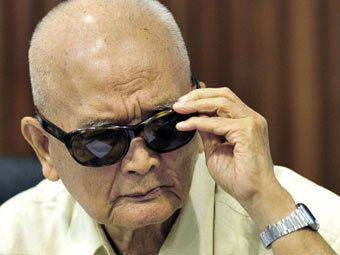
“Brother number two” Nuon Chea (pictured in the courtroom), sentenced to life imprisonment, turned his word into a statement of the official position of the Khmer Rouge. According to the politician, Vietnam is to blame for all the troubles of Cambodia with the python and the deer neighborhood. The second culprit in the tragedy of Cambodia, Nuon Chea, called the United States and their imperialist policies that led to the deaths of millions of people. killing only those who actually collaborated with the Americans or was a Vietnamese agent.
- P P 'SЊSЏ RџRѕR "RѕRЅSЃRєRёR№
- http://vm.ru/news/, maxpark.com, militera.lib.ru,http://aurorasito.altervista.org/, http://fr.questmachine.org/,
Information